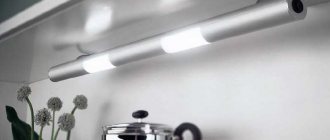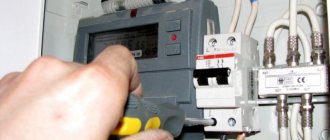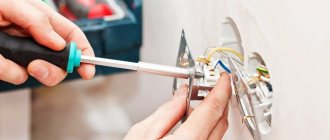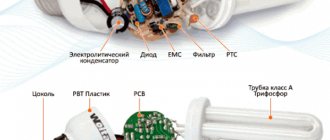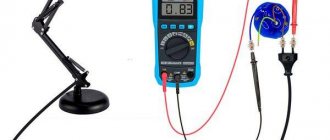Fluorescent lamps are highly efficient due to active mercury vapor placed inside the bulb. Under the action of a discharge, it emits a glow in the ultraviolet spectrum. Such lamps are completely safe for humans throughout the entire period of operation. But there is a danger when they explode. Because if the glass body of the lamp is damaged, there is a significant risk of mercury contamination of the environment and poisoning of people in this room. What should you do if a fluorescent lamp breaks? It is obvious that it is necessary to take urgent measures to dispose of it and neutralize toxic substances.
How to use a fluorescent light bulb
If fluorescent light bulbs are used correctly, they will not cause harm. The following few rules will help prevent a fluorescent lamp from breaking:
Safety precautions when working with electrical equipment: general information and basic measures
A fluorescent lamp has been broken: take precautions and dispose of it correctly!
RCD in power supply circuits of drive frequency converters
- Periodically check the light bulbs for their integrity, especially for those light bulbs that have regularly worked for more than one year.
- It is necessary to check the integrity of the light bulbs before screwing them into the lamps. Even if a new light bulb has minor cracks on the bulb, it is better to return it under warranty with a mandatory indication of the reason for the return.
- Careful handling of the light bulb is the key to the integrity of the mercury flask. You only need to screw it in and out by holding it by the body, and under no circumstances apply force to the glass component, because of this the flask may crack right in your hands.
- You cannot use very tight lampshades and shades - energy-saving light bulbs over 10 watts tend to get very hot, which is why in low-quality and defective products the electrical circuit may catch fire, which will lead to physical damage to the bulb and it may even explode.
- Initially, you need to buy products from a trusted company that guarantees the quality of its products. A good manufacturer monitors the production of light bulbs at all stages of the process, so they arrive at the point of sale fully operational and with the appropriate codes and certificates.
High-quality fluorescent lamps must comply with quality certificates
One of the leaders in lighting
Fluorescent light bulbs in modern apartments and houses are now very actively used to create basic or additional lighting. This is due to the fact that such daylight sources have the following advantages:
- significant energy savings;
Note! Energy savings when using fluorescent lamps are approximately 80%.
Light bulb in action
- quality and durability. The service life of such light sources is 10-12 times longer than that of a conventional incandescent lamp. Thus, the benefits are obvious - once you buy such a light bulb, you will forget about the need to buy a new one for about ten years;
- fairly high parameters of emitted light.
As you can see, the presence of such advantages in the operation of fluorescent lamps allows them to be among the most common light sources. The real benefits of using them will be noticeable almost immediately.
What not to do if a fluorescent lamp breaks
Do not disassemble or repair yourself
Many people, when a light bulb burns out, do not want to buy a new one, but try to fix it with their own hands. Trying to save money. Because in expensive light bulbs the failure is often so small that it can be eliminated by soldering several capacitors. However, it is important to remember that incompetent intervention in the light bulb can lead to depressurization of the bulb, which contains mercury! This is especially dangerous if the toxic substance gets on the skin of your hands. Because there is a high probability of mercury entering the lungs. Therefore, it is advisable to refrain from disassembling the light bulb. You should properly dispose of it and buy a new one, while following all the recommendations in this article.
A list of what else should not be done if a fluorescent lamp breaks:
- In no case should you collect fragments with a vacuum cleaner - it will spread mercury even more throughout the room, and the filters will be saturated with its vapors for a long time;
- also do not turn on the air conditioner and fan;
- do not use a broom - dry material is well saturated with mercury, and glass fragments can get stuck in the broom itself;
- Do not throw the trash bag down the drain.
Radiation
The harm of a fluorescent lamp lies in electromagnetic radiation, which distinguishes it from a conventional incandescent light bulb. The permissible radiation limit is violated within a radius of 15 cm from the light source. Therefore, they should not be used in table and wall lamps, near which you have to stay for a long time.
The electromagnetic field is active when the light bulb is operating, which can lead to the appearance of:
- CNS disorders.
- Suppression of immune defense.
- Diseases of the heart and blood vessels.
Waves can complement other negative environmental factors, so they are harmful to health. With them, “dormant” chronic diseases awaken and protection against viral infections decreases.
What to do if a fluorescent lamp breaks
If a fluorescent lamp breaks, there is no need to panic. The action plan is as follows: remove children from the premises if they are in it, neutralize and collect mercury, collect all glass fragments.
Why you can’t leave a charger in a socket (charger): what the consequences are, reviews
Demercurization of the premises
Demercurization is a process to neutralize mercury that has entered the room openly. This process consists of several stages:
- If you think that when a light bulb is broken, the mercury will be in the form of balls (like in old thermometers), then you are deeply mistaken. And therefore, it is necessary to immediately ventilate the room for at least 2 hours. Use personal protective equipment, gloves, goggles and a chemical respirator. If you don’t have this on hand, because not every home has such a set, be sure to wear rubber or other waterproof household gloves. Using a sheet of thick paper (if you don’t have it, cardboard will do) make a scoop into which you can collect the fragments and mercury powder of a broken light bulb; a rag is convenient for doing this if the fragments have fallen under the cabinet. It is advisable to carry out collection with a damp, thick cloth. All fragments with mercury residues are moved with a rag onto a homemade scoop.
- The rag, dustpan and collected debris should be placed in a thick plastic bag and tied very tightly. For greater reliability, one bag can be placed in several more bags so that the fragments do not cut the polyethylene (also, before moving the fragments into the bag, you can pour them back onto a rag and wrap it carefully).
- Do not allow splinters to remain on the floor for long periods of time. It is advisable to treat the place where the lamp fell and broke with a solution of potassium permanganate or any bleach based on active chlorine. If this happens on the carpet, then it needs to be taken outside, carefully but thoroughly shaken out, and left to air out as much as possible.
- The bag should not be thrown into a container or trash can with other waste. It must be handed over to the nearest organization that disposes of mercury, for example, a fire department, housing office or private office. They will accept your package free of charge or for a nominal fee, after which the mercury will be neutralized with special chemicals, and the glass will be sent for recycling.
Broken fluorescent lamp: take precautions
Why you shouldn't throw a broken lamp in the trash
The above steps will not allow a broken light bulb to pollute the environment with mercury vapor, no matter how much it is contained inside. After neutralizing the mercury, the fragments can serve as material for the production of a new product, which will significantly reduce production costs and preserve the environment. This occurs subject to the removal of the broken lamp to special institutions that work under an agreement with the manufacturers. Modern production of compact fluorescent lamps is gradually being reduced due to the difficulty of recycling mercury, so the material will be used to manufacture a new trend in lighting technology - LED lamps.
RCD in power supply circuits of drive frequency converters
User input into the recycling process
Theoretically, this operation does not pose any difficulties. So, all a person needs is to perform a few simple actions in a certain order.
Which are the following:
- A burnt-out fluorescent lamp must be packaged in a complete plastic bag. Which will prevent mercury poisoning in the event of unexpected depressurization during the disposal procedure.
- Take the device to a collection point.
- use the Internet;
- call back to the management organization, housing office, Ministry of Emergency Situations.
It should be remembered that the dismantling, transportation, and storage of a used lighting device cannot be treated negligently. For example, placing it in a regular trash bag or leaving it in another place where accidental damage may occur.
After completing all of the above, the owner’s mission will be considered completed. But in practice everything is more complicated, the reason for this is the insufficient number of places intended for collecting fluorescent lamps.
The disposal procedure is lengthy and labor-intensive. But the main and only task of the owner of used fluorescent lamps is to hand them over to a collection point. Why do you need to find a container similar to the one shown in the photo?
According to the governing documents of almost all countries in the post-Soviet space, the collection of unusable lighting fixtures containing mercury should be handled by the management of apartment buildings. These include residents' associations, management organizations, and also such responsibilities are assigned to housing and housing departments and REUs.
For example, in Moscow, absolutely all housing maintenance offices are equipped with the necessary equipment for collection and are serviced by trained specialists.
But the majority of the country’s housing and communal services managers, for various reasons, ignore such requirements, so these items are quite rare in a number of regions. But they exist, at least in all major cities.
And to find the nearest one, it’s enough:
Often, officials are helped out by commercial organizations and collection points for all kinds of mercury-containing lamps are created in retail chain stores, and often even at battery collection points. For example, in Russia they are available in many IKEA supermarkets.
In addition, concerned citizens can call on the management of housing and communal services in writing to fulfill their duties. Moreover, equipping the point is a simple procedure. Because all you need to do is install a small, durable container.
If there is no specially equipped container nearby, then citizens have the right to apply in writing to the housing office or management company with a request to acquire one. Moreover, it is allowed to use all kinds of containers as a collection that can prevent depressurization of mercury-containing flasks
And the reception can be carried out by full-time electricians of housing and communal services, management companies, who subsequently transfer the devices that have served their purpose for recycling, which is convenient for residents.
In addition, such an order is not difficult to organize, since special skills or any special tools are not required for this.
It is definitely worth remembering that at lamp collection points, responsible persons will only accept sealed products, that is, intact ones with no signs of damage.
If they are in unusable condition, they should not be transported or attempted to be disposed of. Because it can be dangerous to health. In view of this feature, when the lamp in the room has depressurized, it is better to call representatives of the Ministry of Emergency Situations.
You also need to know that all products that have not reached the warranty period can be returned to the selling organization. In such cases, there is even the possibility of a refund or replacement.
The duration of the warranty period can be up to 2 years; sometimes you can find out the exact information by studying the data indicated on the packaging.
How else can you quickly remove the remains of a broken fluorescent lamp?
To efficiently remove small fragments, you can use stationery tape, gluing sticky strips to the place where the light bulb was broken. The glue collects glass well, which is invisible to the human eye due to its small size, and also glues remaining mercury, which increases the quality of assembly. There is no need to call a special service for demercurization. Because a small mercury content will not lead to a global environmental disaster.
The mercury content in fluorescent lamps depends on their power and is 0.1-0.5 grams. If mercury from a broken thermometer in the form of balls is relatively easy to collect, then with its vapors everything is much more complicated. And, although the contents of the flask are not fatal to humans, nevertheless, there is a very real danger of poisoning. When a fluorescent lamp breaks, the very first action to neutralize harmful substances is to ventilate the room. Due to this, the concentration of mercury vapor is noticeably reduced, the main thing is that this procedure is carried out in a timely manner.
After complete removal of particles, it is necessary to treat all surfaces with a special solution, which can reduce the concentration of vapors. It is permissible to prepare the solution yourself. Preparation in three ways is possible: 2 grams of manganese are dissolved in a liter of water; for 10 liters add 400 grams of soda and part of liquid soap; Dissolve 100 ml of iodine in a liter of water. This procedure takes 3–4 days. The resulting composition is applied to the affected area and left for 6-8 hours. Particular attention should be paid to the cracks between the floorboards, where mercury could roll in and the phosphor could spill out. There is no need to spare the solution - our health depends on the quality of demercurization.
It is necessary to treat the surface with a solution that can be prepared from available ingredients
What is an overcurrent circuit breaker and how to choose one
Effect on vision
Fluorescent lamps are known to be harmful to the eyes. This applies to light sources with LEDs. The reason for this is that the "daylight" light waves appear due to the use of blue and yellow diode. Blue radiation is harmful to the eyes and affects the retina. The risk zone includes:
- Children, because they are sensitive to the effects on the eyes of energy-saving devices. They do not have a formed crystal of the eyeball, and therefore there is no protection from ultraviolet radiation.
- Persons with macular degeneration.
- People during drug treatment.
Dangerous consequences of broken fluorescent lamps
Many people are very aware of the harm that mercury can cause to the body. The mercury vapor contained in the flask is much more dangerous than mercury in its pure form. Their main harm lies in the fact that from a destroyed lamp they enter directly into the respiratory tract, and then penetrate into the body through the lungs.
Mercury belongs to the first class of hazardous substances according to the FKKO, so it causes a negative reaction in the body even in very small amounts of grams when a person inhales it. It has a cumulative property, that is, in a short time, biological tissues accumulate mercury, and it is very difficult to remove it. Symptoms look like typical toxic poisoning:
- sharp abdominal pain;
- nausea and diarrhea with blood;
- heat;
- inflammation of the lungs and gums.
Mercury is especially dangerous for pregnant women. Mild poisoning is manifested by apathy, memory loss, drowsiness, and bad mood. If such symptoms are observed after disposal of fragments, urgent hospitalization of the victim is necessary, where doctors will prescribe special substances that neutralize the harm of mercury in the body.
Color and alphanumeric markings of electrical circuits
Symptoms of mercury vapor poisoning
What to do if you have severe mercury poisoning
The most dangerous variant of mercury vapor poisoning is acute poisoning, and in this case a large amount of mercury vapor enters the human body over a short period. In this case, the consequences will not take long to arrive. A couple of hours and the primary signs of poisoning will appear. And they are diverse. From abdominal pain to bloody diarrhea, from pneumonia to swollen gums, nausea and vomiting. Most often the temperature rises to at least thirty-eight degrees. In case of particularly severe poisoning, death is possible. But let's not talk about sad things. This is actually not a common occurrence. Most likely, a broken light bulb will not poison you, but no one has canceled safety precautions.
How to fix bluetooth headphones for a phone, if one doesn’t work, the microphone or plug is broken, the contact has come loose and other cases
It is more dangerous to break a hot energy-saving fluorescent lamp. The most harmful fumes are hot ones. According to statistics, mercury poisoning occurs extremely rarely in domestic conditions, but, however, you need to be careful not to become one of the sad statistics.
The effect of mercury lamps on human health
Two more types of mercury poisoning not associated with a broken lamp
The next two types of poisoning have nothing to do with a broken lamp at all, but it is useful to know about it. At a minimum, to know how to act in such a situation. The first of these is chronic mercury vapor poisoning. It occurs as a result of prolonged exposure to vapors with a slight excess of mercury content. This impact can last up to several years. And it affects the central nervous system. Depending on the type of lesion, symptoms appear. It could simply be fatigue, drowsiness or apathy. In more severe forms, the effect on the brain is manifested, and this is bad. There may be memory loss and severe tremors in the limbs.
Meter box: requirements for a metal case for outdoor installation of a meter
The second form is micromercurialism. This poisoning occurs gradually. As a rule, over a very long period of time, the body is constantly exposed to a tiny concentration of mercury vapor. Long before the appearance of primary symptoms, the ability to smell is sharply reduced. Signs of such poisoning include decreased performance, drowsiness, apathy and memory loss. This general poisoning of the body also leads to a reduction in immunity. Most often, such poisoning occurs in those who work in mercury-related industries and neglect safety measures. But the reasons may be different, and such poisoning is possible in domestic conditions. Especially in cases where the mercury from the broken thermometer was not carefully removed. It can lie in the folds of the parquet, evaporate and slowly poison you.
Impact on the environment
Mercury contained in lamps has a harmful effect not only on humans, but also on plants. The component accumulates on vegetation located on soils with low concentrations. And with an increase in this substance in the soil, this amount increases in the above-ground and root organs of plants. An increase in humic acids in the soil reduces the amount of mercury absorbed by plants due to the formation of organomercury complexes.
Under the influence of microorganisms, the complexes are destroyed with the appearance of metallic mercury, which passes into the atmosphere. Algae absorb mercury from contaminated soil and are a source of it for organisms. In higher plants, roots are considered a barrier that accumulates it. Mercury in the atmosphere in the form of vapor is retained by spore-bearing and coniferous plants. This leads to inhibition of cellular respiration and decreased enzymatic activity.
Mercury also has harmful effects on animals. Salts are absorbed by aquatic organisms. Fish also accumulate this component and retain it in the form of methylmercury. It is believed that the component entering the water accumulates and transforms in each link of the aquatic food chain. Maximum content is achieved at the top. In animals with accumulation of mercury, important functions are inhibited, as well as a decrease in the viability of the offspring.
How much mercury is in an energy-saving light bulb?
The concentration of mercury inside an energy-saving light bulb depends on its type and power. Each manufacturer indicates the indicator on the individual lamp packaging:
- Room ESL contains up to 5 mg of mercury.
- DLR lamp – up to 350 mg.
- Luminescent tubular – 45–65 mg.
- DRT lantern – up to 600 mg.
- Neon tube – up to 10 mg.
Experiment with a broken fluorescent lamp
Attention! Back in 2004, applied research was carried out on breaking down fluorescent lamps. “Full-scale tests” were carried out inside a closed container in which an energy-saving lamp broke. The experiment gave the following results:
Replacing electricity meters: at whose expense is the electricity meter changed and in what case
Mercury vapor is dangerous to human health
- Immediately after breaking the flask, more than 50% of the total amount of mercury vapor it contained is released.
- Mercury in amounts up to 40% is gradually released from the fragments in the form of vapor. (The remaining amount remains on the bound inner lining of the broken flask).
- In the first 24 hours, approximately half (i.e., up to 20% of the total amount) of the toxic metal is released from the fragments. As a result, after 24 hours, at least 70% of 2.5 mg of mercury (the most common content) will accumulate in the atmosphere of the apartment, if ventilation is not done.
- In high-quality foreign lamps, mercury is usually contained in a special bound state, in the form of a so-called amalgam. And when the lamp breaks, mercury in contact with air should not spread in space. Chinese analogues, if damaged, pose a real danger. One light bulb can contain up to five milligrams of mercury. For comparison, for example, a thermometer contains only 2 mg of mercury. And since it is in a gaseous state in the lamp, its distribution in the air occurs very quickly. The minimum safe daily dose of mercury for one person is 0.0003 mg/m3.
How to correctly report data for electricity: how to transmit, when and in what way
Hazard Control Measures
Mechanical cleaning
To ensure safe operation of the room in which the energy-saving lamp was broken, it is necessary to carry out a set of measures to clean it from vapors and mechanical residues of the product:
- A responsible adult must take on the job of cleaning the apartment or premises. Everyone else needs to leave the affected area, taking their pets with them.
- To avoid the spread of contaminated air, the door of the room is tightly closed, and to reduce the concentration of toxic substances, windows, vents and a balcony (if there is one) are opened wide.
- The next step is to clean up the parts and shards of the lamp. It is extremely important to avoid contact with fragments and particles of the flask with bare hands - work is carried out exclusively with latex or rubber gloves. To collect the fragments, it is better to take a kitchen sponge, towel, rag, cardboard or paper. It is better not to use a vacuum cleaner or any other valuable items, because they will have to be disposed of after cleaning.
- The collected fragments must be placed in a bag made of dense material. It should be fastened and ensure tight storage.
- The surface on which the fragments were located is wiped with a damp towel. It is also sent in a sealed bag, where the fragments were poured.
- If lamp particles fall on furniture, pillows or other soft household items, they should also be placed in sealed bags. In the future, it is necessary to conduct an examination for the content of harmful metals in order to understand whether you can continue to use them or throw them away.
- If splinters are scattered on the carpet, it should be taken outside and thoroughly beaten out. The blows must be applied to the reverse surface. In this case, the surface under the knockout platform should be lined with an old oilcloth, sheet, tablecloth or blanket. The fragments are hazardous to the environment, so they must be collected in this way for further disposal. After beating, the carpet should be ventilated for a long time, reducing the concentration of toxic substances.
At this stage, measures have been taken to mechanically clean the premises. All fragments and the materials with which they were collected must be disposed of in a special container, which must be installed in each populated area. Throwing mercury waste into ordinary trash cans worsens the environment and increases the risk of injury to people and animals.
Demercurization
After mechanical cleaning, the room in which the energy-saving light bulb has broken must be demercurized. This means neutralizing mercury compounds and vapors. The procedure involves cleaning the room using special solutions. You can prepare them at home using one of the following recipes:
- dissolve 2 grams of potassium permanganate in 1 liter of water;
- dissolve 400 grams of soda and soap solution in a 10-liter bucket of water. A chlorine-containing product like “Belizna” is suitable as a replacement for soda;
- Dissolve 100 ml of iodine in 1 liter of water. This option is more suitable for objects with a large affected area.
The resulting mixtures are used to treat surfaces in the room where the accident occurred. Particular care should be taken to wipe hidden cavities and hard-to-reach areas such as cracks between floorboards. It is recommended to keep the solution on the surface for several hours, and carry out the mercury neutralization procedure daily for 3-4 days. Naturally, to maintain health, you need to protect your hands with rubber gloves.
If a fluorescent lamp breaks, after disposing of the fragments, you can contact a company that does this professionally for demercurization services. Moreover, specialists will use special means for treatment that are more effective in neutralization. In addition, such companies help measure the concentration of mercury vapor in the air after treatment and determine whether objects that were exposed to fragments after a lamp rupture are suitable for use.
simplelight.info
Types of mercury lamps
The main types of lamps containing mercury are presented in the following list:
- Fluorescent tube lamp. This is a well-known fluorescent lamp (LDS). It can be seen almost everywhere: in everyday life, public places, offices, industrial premises;
Tubular (LDS - fluorescent lamp)
- UV lamp. It is also called quartz, although this is not entirely true. The filling of such a lamp is the same as that of an LDS, only it does not have a phosphor and is made of special glass. These lamps are also found everywhere: in household disinfection devices, solariums, beauty salons, medical institutions, etc.;
Quartz (ultraviolet) fluorescent lamp
- Compact fluorescent lamp (CFL). In essence, this is the same LDS, only compact and having built-in control gear. There are these in almost every home - they have replaced incandescent lamps;
CFL
- Mercury arc lamp (MAL). This device recently served as the main source of lighting for streets, roads, and industrial enterprises. Nowadays it is found somewhat less frequently, but is still very popular;
DRL
- Sodium arc lamp (HSA). This is also an industrial lamp. She slightly pushed aside the DRL devices, but only a little - her light was too orange. The device can be seen in cantilever street and road lamps;
DNAT
- Metal halide lamp (MHL). The scope of application is the same as that of DRL devices. In addition, it can be found in relatively “household” devices - movie cameras, projectors, episcopes, etc.
MGL
How to properly design corners on a ceiling plinth
